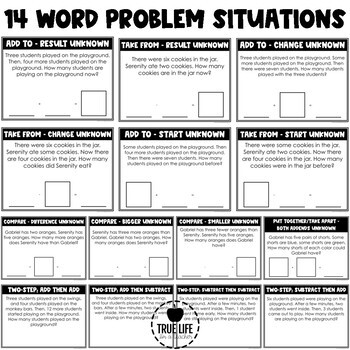2nd Grade Word Problems for the Year
- Zip
What educators are saying
Description
2nd Grade Word Problems for the Year is a complete, year-long word problem curriculum covering 14 different one and two step word problem situations throughout 180 word problems.
First 9 Weeks - One-Step; No Regrouping
Second 9 Weeks - Two-Step; No Regrouping
Third 9 Weeks - One-Step; with Regrouping
Fourth 9 Weeks - Two-Step; with Regrouping
This is a comprehension word problem resource. Here's what's included:
- Curriculum Information (rationale, standards, how I fit everything in to my math block, year-long pacing guide, weekly plan/routine, rubric, providing feedback, and a visual representation of the word problem situations included)
- Word Problem Situation Anchors (use for student notebooks, class anchor chart, examples)
- 180 Word Problems (36 weeks planned in a sequential, strategic way)
Do your students get frustrated with word problems? Do they struggle to understand when to add and when to subtract?
Word problems have always been a source of contention for my students, and have always been something I’ve taught haphazardly as part of an adopted math curriculum.
I used to teach my students to use key words, underline, and circle, highlight, and box...and yet, it didn’t help. My students didn’t understand or perform any better. It didn’t help that I wasn’t consistently teaching or letting my students practice solving word problems.
When I started teaching word problems (or math stories) in a consistent, strategic way my students became less frustrated, and much more proficient word problem solvers.
Now, I follow a 4-day teaching plan, and assess on day 5. I no longer teach key words or underlining, circling, highlighting, and/or boxing...instead, I teach my students to look for patterns in how word problems are structured... word problem situations. In addition, I dedicate 5-10 minutes each day for word problem teaching and practicing.
My hope is that by using this curriculum, your students will learn to look at word problems like a detective, and search for the situation within the words.
CCSS.MATH.CONTENT.2.OA.A.1
Use addition and subtraction within 100 to solve one- and two- step word problems involving situations of adding to, taking from, putting together, taking apart, and comparing, with unknowns in all positions, e.g., by using drawings and equations with a symbol for the unknown number to represent the problem.
Addition/Subtraction within 100 One-Step & Two-Step
Add to
Take from
Put Together/Take Apart
Compare





